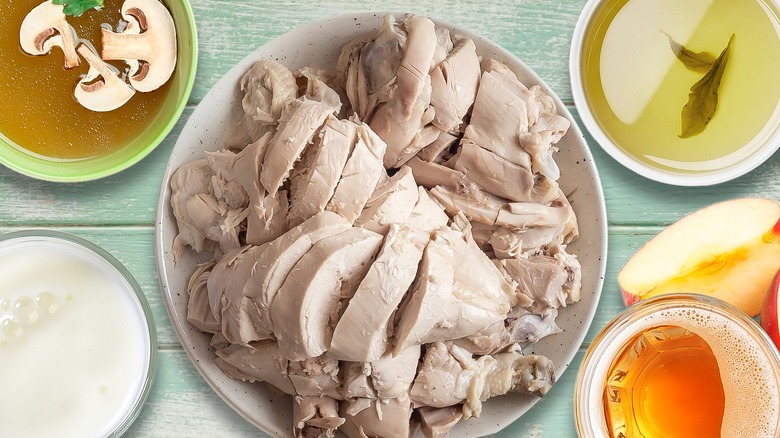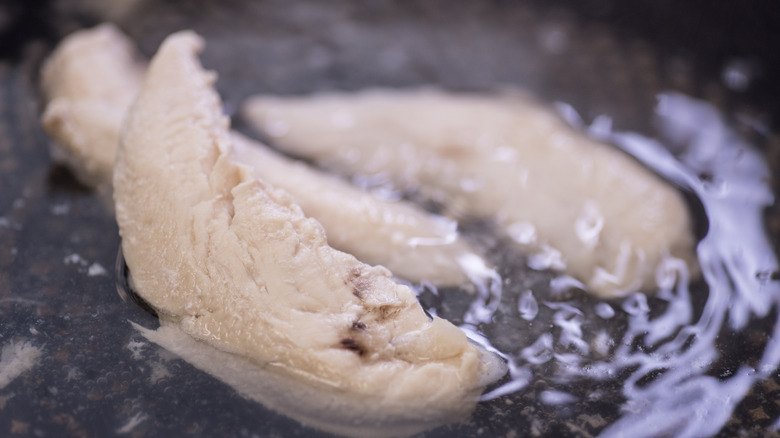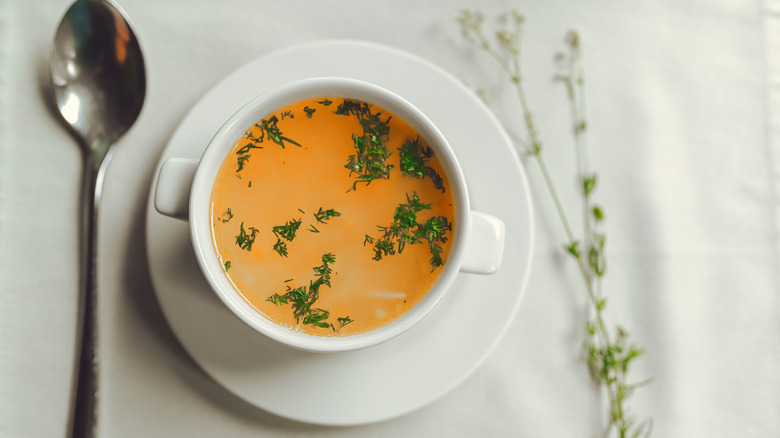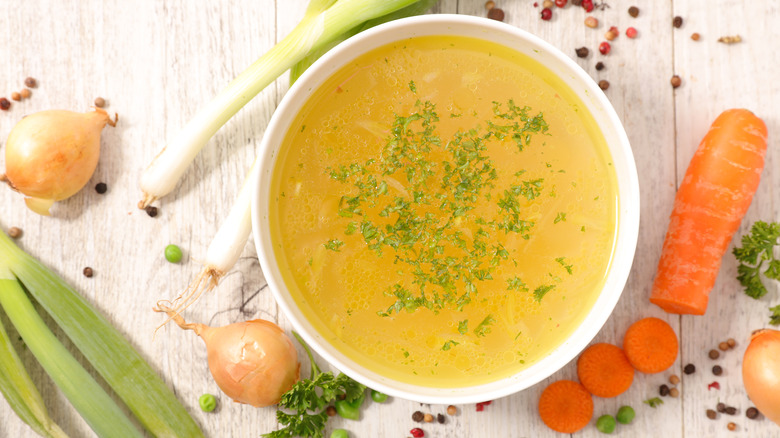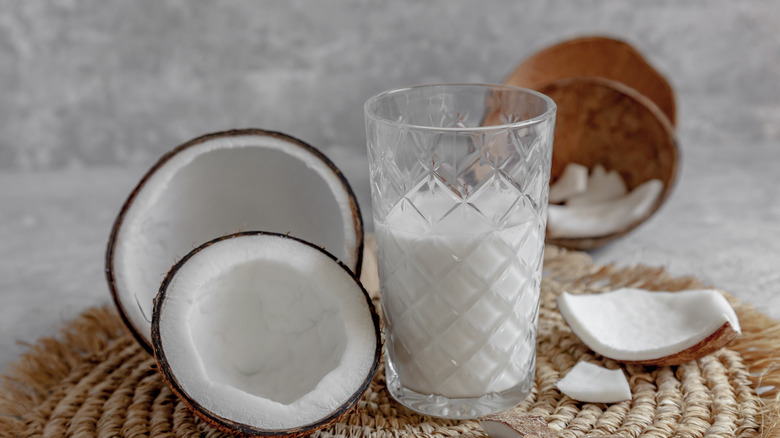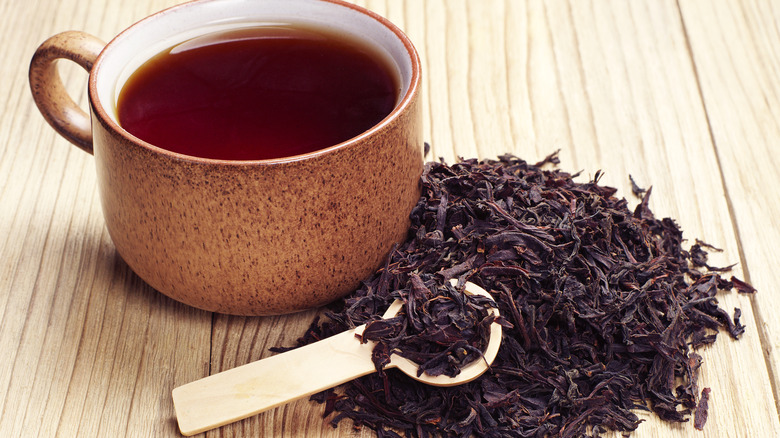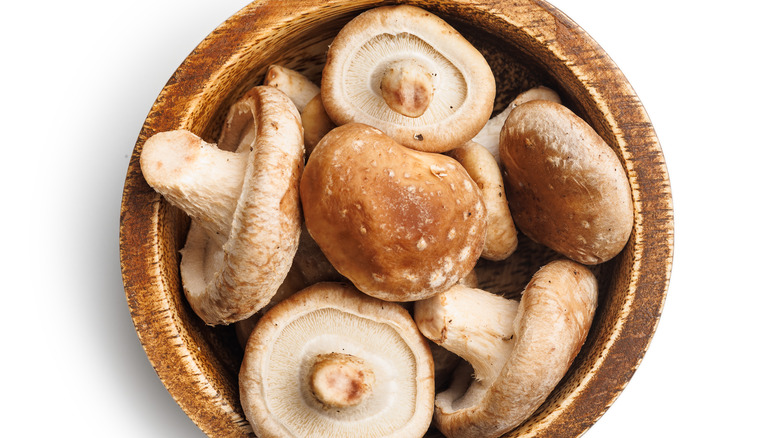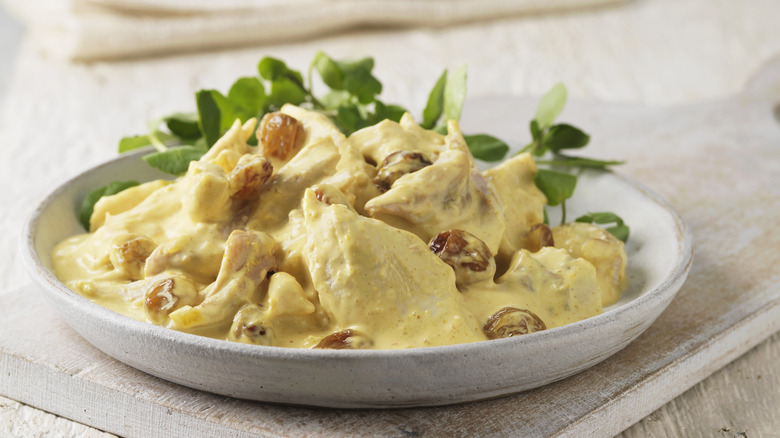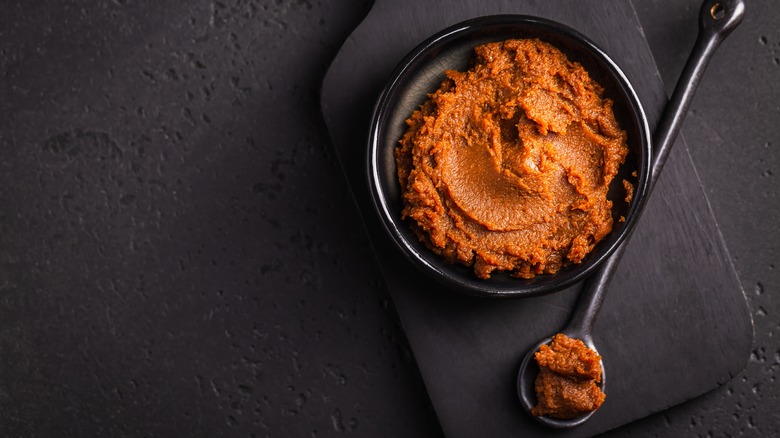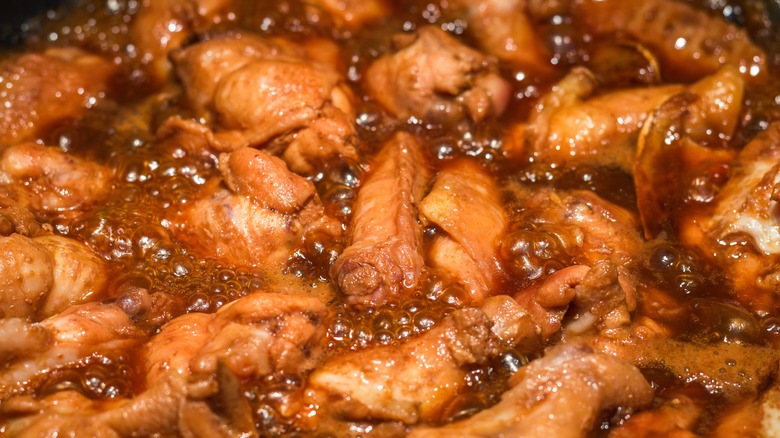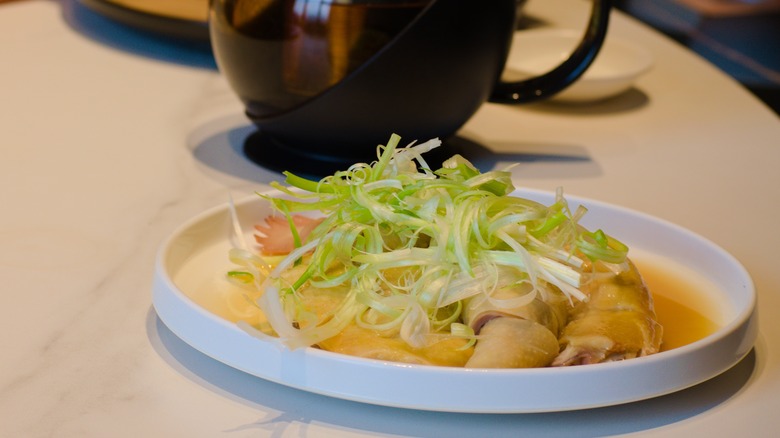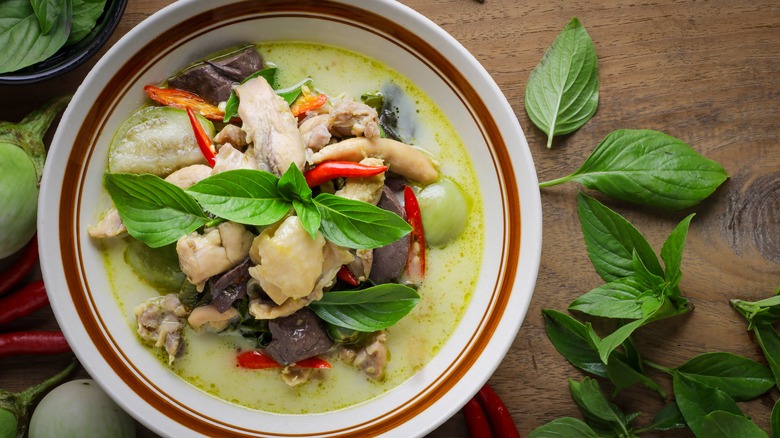12 Best Liquids For Poaching Chicken
Poaching is an underrated way to cook chicken, and this technique can result in a tender and succulent dish. While it's a popular method in various cultures, it doesn't seem as beloved in America when compared to other cooking styles like grilling or roasting.
Perhaps the idea of poached chicken conjures up images of boiled, rubbery, and tasteless poultry — but in reality, poaching chicken can result in juicy, flavorful meat. Sure, poached chicken will always have a more neutral taste than chicken that's grilled, roasted, or pan-fried, as these techniques achieve browning through the Maillard reaction. But that doesn't mean there's no place for poaching, and there are times when perfectly poached chicken is just the type of comfort food you need. Poached chicken is great for shredding into salads and making sandwich fillings, which can be useful for warmer months when we're making cold food for picnics, outings, and gatherings.
Poaching is different from boiling, in that this technique involves cooking at a lower heat, which lets the chicken take its time to heat slower than at a rolling boil, which can easily overcook the meat. There are also various ways to impart flavor to your chicken by using different poaching liquids, as you're not limited to relying on plain water. This is where you can get creative. As a recipe developer who has made all kinds of poached-poultry dishes, these are what I've found to be some of the best liquids for poaching chicken.
Salt water
Many people think that poaching chicken involves a complicated process with special ingredients. However, people poach chicken all over the world with the simplest of ingredients. Really, all you need to make tasty poached chicken is water and salt. This will result in plain poached chicken that you can always enhance with condiments and sauces after cooking, or just keep it plain to be shredded into soup or chicken salad.
Naturally, you can add whatever other ingredients you want to the salted water for a flavor boost. For example, my family loves to add cardamom pods to the salt water to lightly perfume the chicken.
The key when poaching with salt water is to make sure there's enough salt so that your chicken tastes well-seasoned. If the salt is absorbed into the meat, your chicken will be tasty and won't require too much else. What's in the water is important for the taste, but the simple trick for more succulent poached chicken has to do with the water's temperature. Many people make the mistake of adding chicken into hot or boiling water, and this causes the poultry to seize and firm up, releasing its moisture and toughening the meat. Instead, start with cold or room temperature water, and build up the temperature gradually. This is a gentler process, and allows the chicken to cook slower, keeping the meat more moist and tender.
Chicken stock
It might seem redundant to use chicken stock to poach your chicken, but this actually makes perfect sense. Instead of using water, chicken stock provides an easy way to make your chicken a little more flavorful. The added benefit is that you can shred the chicken back into the broth once it's cooked, and you'll immediately have a satisfying chicken soup.
With this method, you can take a shortcut and use a stock cube or some ready-made chicken stock, and all you need to do is give it a taste and make sure it's well-seasoned to your preferences. After all, how it tastes is going to define how your poached chicken tastes.
If you're making your own stock from scratch, keep in mind that you need to give it time to develop flavor before adding the chicken. Chicken can cook really quickly, depending on the cut — often quicker than it takes for your alliums or herbs to infuse your stock properly. So, if you want a more robust stock that makes an even tastier poaching liquid for your chicken, simmer your aromatics first. Even if you're using a stock cube, it doesn't hurt to bolster it with some fresh produce like onions, shallots, garlic, rosemary, or thyme. Just remember to let the stock simmer for a while before dropping in the chicken.
Vegetable stock
You can use any kind of stock to poach your chicken, and it's not necessary to stick with chicken stock. This makes it easier if you're making your stock from scratch, because vegetable stock doesn't require you to have pre-boiled chicken the way chicken stock would.
Using vegetable stock can be a really tasty way to poach chicken, and the flavor often tends to be a little sweeter and more delicate. If you don't know where to start with making a stock, stick with the classics like carrots, onion, and celery. Then add whatever you like the taste of, such as garlic, peppercorns, ginger, scallions, rosemary, thyme, cloves, or cardamom. It's always a good idea to taste as you go along to adjust the salt level.
A nifty trick for making vegetable stock is to prepare in advance by keeping your vegetable peels and scraps in a plastic bag in the freezer. Whenever you peel a carrot, for example, keep the skins and place them in this bag. This is not only a great way to reduce food waste, but it means that you always have a bag of vegetable trimmings at the ready to use for vegetable stock. Of course, you can use a vegetable stock cube too, or a combination of both. As with chicken stock, it's about giving everything enough time to simmer together for the flavors to develop.
Coconut milk
For a creamier and slightly sweeter take on poached chicken, you can use coconut milk as a poaching liquid. Canned coconut milk works great, and if you only have canned coconut cream, all you need to do is add a little bit of water and you've got coconut milk. All the same things apply when poaching in coconut milk, and you still want to start cold and slowly warm up to a light simmer. You also want to season the coconut milk with salt (and pepper, if you like). Keep the coconut milk plain or add in the aromatics you like to flavor it even more. For a Thai-inspired coconut poached chicken, you might consider adding in some lemongrass and ginger, or even some fresh chiles.
What's handy about using coconut milk as a poaching liquid is that once you remove the chicken, you can simmer it down and make a delicious sauce to pour over the meat. This is especially delicious if you've added aromatics like lemongrass, and then finish off with some squeezed lime juice and fresh cilantro.
Tea
Tea makes a dynamic poaching liquid for all sorts of things, and chicken is one of them. That earthy, smoky flavor of tea works wonderfully in savory dishes, and it absorbs into your chicken meat during the poaching process. If you use black tea, you'll have the added benefit of an aesthetically appealing bonus as the tea gently seeps into your chicken and gives it a beautiful amber hue. If using tea as a poaching liquid intimidates you, please don't let it. It can be as simple as throwing a couple of tea bags in some warm water, then removing them once they've infused the water. You can also opt for loose leaf tea and then use a mesh strainer to remove the leaves from the liquid. To this, you might consider adding other aromatics, like star anise, cloves, peppercorns, or whatever you think would complement the tea flavor.
You don't have to stick to black tea either. You can play around with different teas and choose the flavor that works for you. If you dislike the taste of black tea, white tea could make a good alternative as it has a milder and more delicate flavor. In fact, white tea is a brilliant swap to make with water, when you want to steam or poach all kinds of dishes, from fish to pork buns to chicken.
Mushroom broth
Mushrooms are an underrated ingredient for making powerful tasting broth, and they can make an incredible poaching liquid. Mushrooms and chicken are a match made in heaven, so this isn't a far stretch in any sense. Mushrooms are a rich source of umami, which is perfect for a savory broth. Some of the mushrooms with the most potent umami are shiitake, portabella, crimini, and white button. Dried mushrooms have even more umami than fresh ones, so opting for dried mushrooms is even more impactful when added to any broth.
You can either add in a few mushrooms to your vegetable or chicken stock for a deeper, earthier tasting stock, or take inspiration from this mushroom broth recipe and use dried shiitake mushrooms. As in this recipe, it's important to rehydrate your dried shiitake mushrooms for a few hours if you want them to reach their full savory potential. If you simply add them to your warm broth, they may become soft and edible, but will lack the robust flavor they're known for.
Milk
Milk makes a great poaching liquid for proteins like chicken and fish. It's naturally rich and creamy, and it does a great job at absorbing other flavors like onion, garlic, and more. That's why it's an easy choice for poaching, as you can lightly simmer some chicken in milk along with other aromatics to get a delicate, creamy meal at the end. This is especially the case because, once you've poached your chicken, you can remove it and turn your poaching milk into a creamy sauce for your meal by either reducing it or thickening it up, and then adding more seasonings or spices to the mix.
You might even consider mixing liquids, like adding some chicken or vegetable broth to the milk to get the best of both worlds. It's important to avoid adding any acid to the milk, however, to avoid it curdling and becoming cheese — but otherwise, have at it with ingredients like peppercorns, thyme, celery, mushrooms, and more.
Miso
Few ingredients exist that rival the ratio of low effort to maximum flavor like miso. It takes literal seconds to dissolve some miso paste in water and have a potent, salty, umami broth that you can use for so many things. If you're unfamiliar with miso, there's no reason to be intimidated. This fermented soybean paste is a wonder, and it adds complexity and depth to sauces, soups, and broths, making it a no-brainer for poaching chicken with. The flavor is strong enough to penetrate and flavor your meat, and you'll be left with a little miso soup leftover that you can shred your cooked chicken back into, or even turn it into a miso sauce to serve with your meal.
With miso, you don't have to take any extra steps of soaking, refrigerating, or simmering for long to develop a flavor. Miso paste is basically an instant flavor hit, only requiring you to add a spoon (or several, if you love it) to some water and mixing. You won't need to add extra salt or other seasonings, as miso is salty enough and has an all-rounded flavor on its own (however, you can, if you wish to).
White wine
White wine is a popular poaching liquid for chicken and can result in tender and moist meat. Your chicken won't taste strongly of wine, but it will have a subtle zing to it. Plus, you should reserve the poaching liquid after your chicken is cooked to make a delicious white wine sauce that will go great with your meal.
You can use any wine to poach chicken, but white wine is a good choice because it goes better with white meats in general. Red wine, however, will stain your chicken meat red, which could be unappetizing. You also don't have to use an expensive white wine for poaching — any type will do. You might consider making a poaching liquid of straight wine and aromatics, mixing wine with water, or adding wine to a vegetable or chicken broth to add extra flavor. To make a delicious and creamy wine sauce with your leftover poaching liquid, you can also throw in some butter, fresh parsley, and a roux to thicken it up.
Coca-Cola
This may seem like an outrageous thought to many people, but that fizzy, sugary bottle of Coca-Cola in the fridge is more than just a popular soda to quench your thirst with on a hot day. In fact, Coca-Cola (or alternative cola drinks) can be really useful in savory cooking. Of course, if you're opposed to high-sugar foods and beverages, then this one isn't for you. But Coca-Cola is a flavor powerhouse for poaching chicken, and it can impart more than just sweetness to the meat, but also notes of caramel, citrus, cinnamon, and more.
It's a relatively popular substitute for hard-to-find ingredients when making a traditional Cantonese soy sauce chicken, as it replaces things like rock sugar and other medicinal herbs. Mixed with soy sauce, another umami-packed ingredient, and you've got a sweet, savory, and tangy poaching liquid. Coca-Cola is also a great option because, if you let it simmer for long enough, the liquid will evaporate, and the sugars will caramelize into a sweet glaze that you can then pour over your poached chicken.
Ginger and scallion broth
Chinese cuisine has various poached chicken recipes that we can learn from — and one of the most beloved is white cut chicken. This Cantonese dish is especially eaten during the Lunar New Year, and it's simply served with a scallion and ginger oil served over it. To bring uniformity to the dish, the poaching liquid usually also includes these ingredients (and sometimes, Chinese cooking wine). This simple addition to the water creates a light poaching broth that's perfumed, and it allows the chicken to cook in and absorb the aroma of ginger and scallions while poaching.
White cut chicken is usually a whole poached chicken that's expertly cut up once cooked, but you can also use chicken pieces or breasts to recreate it. Whatever you do, don't discard your poaching liquid, as it can be used as a base for chicken soup later on.
Curry sauce
One of the tastiest and most convenient ways to poach your chicken when making chicken curry (whether Thai, Indian, or any other type of curry) is to simply cook it in your curry sauce. There's a common misconception that when you're making a chicken curry (or frankly, anything saucy like stew or soup), you need to first brown the meat. If you're using the same pot, you then remove the browned chicken to make your curry sauce, only for the chicken to be added in later on.
However, this is simply too many steps and pretty redundant, unless you really have the specific desire for the flavor of browned chicken (which isn't very pronounced in something like a curry anyway). With curry, there's already plenty of flavor going on, so having browned meat isn't necessary.
There's also no need to poach your chicken first, then shred it and add it into your curry, as poaching it in your curry will help it absorb all the flavors of the curry and become one with the dish. The trick with poaching your chicken in your curry, however, is timing. You don't want to add it in when you're still developing your sauce and taking time to cook it over, or you can easily overcook the chicken. It's best, then, to add it right at the end on low heat — along with any other short-cooking vegetables like spinach or peas — which can be turned off as soon as the chicken has cooked.
